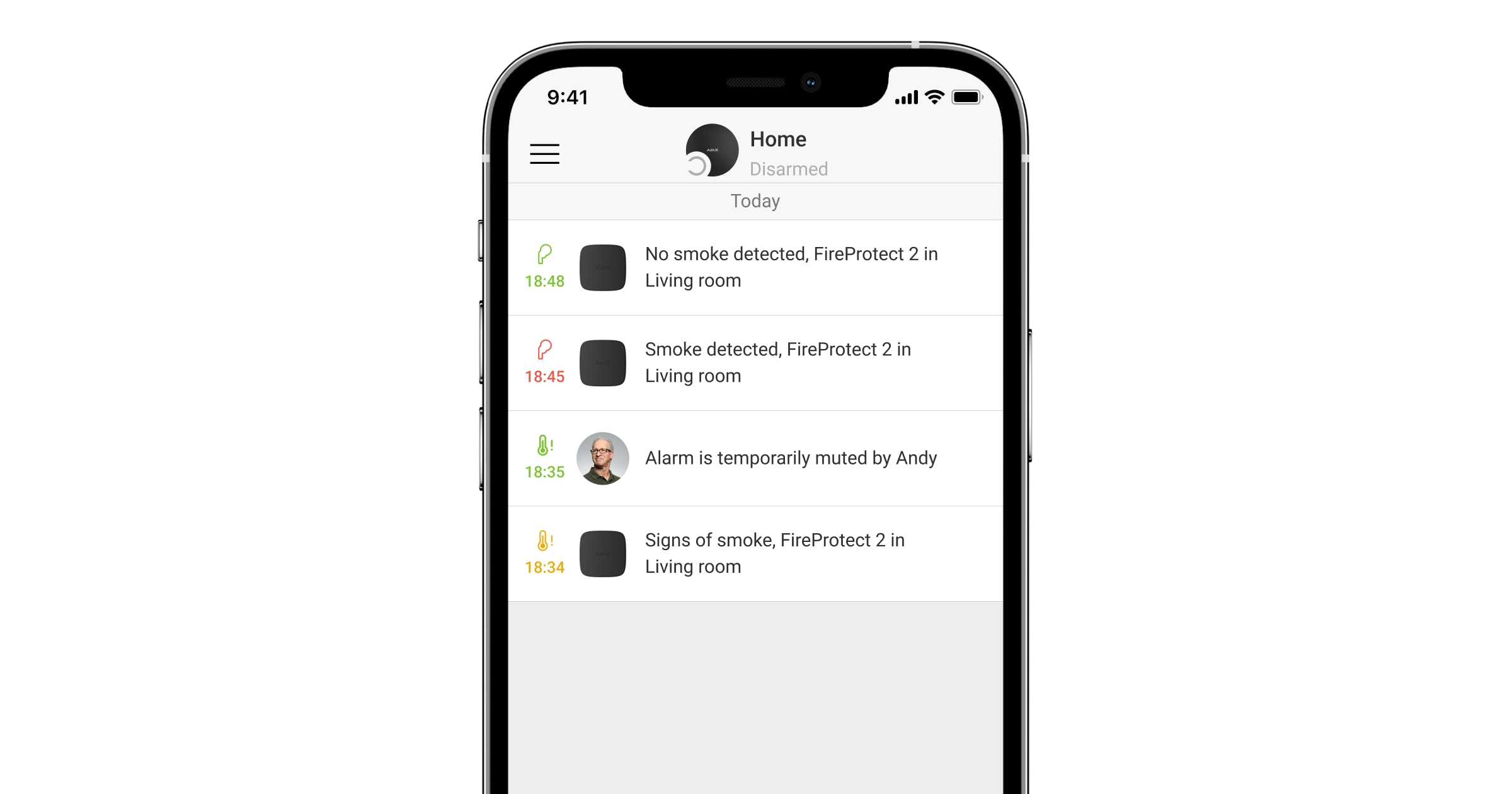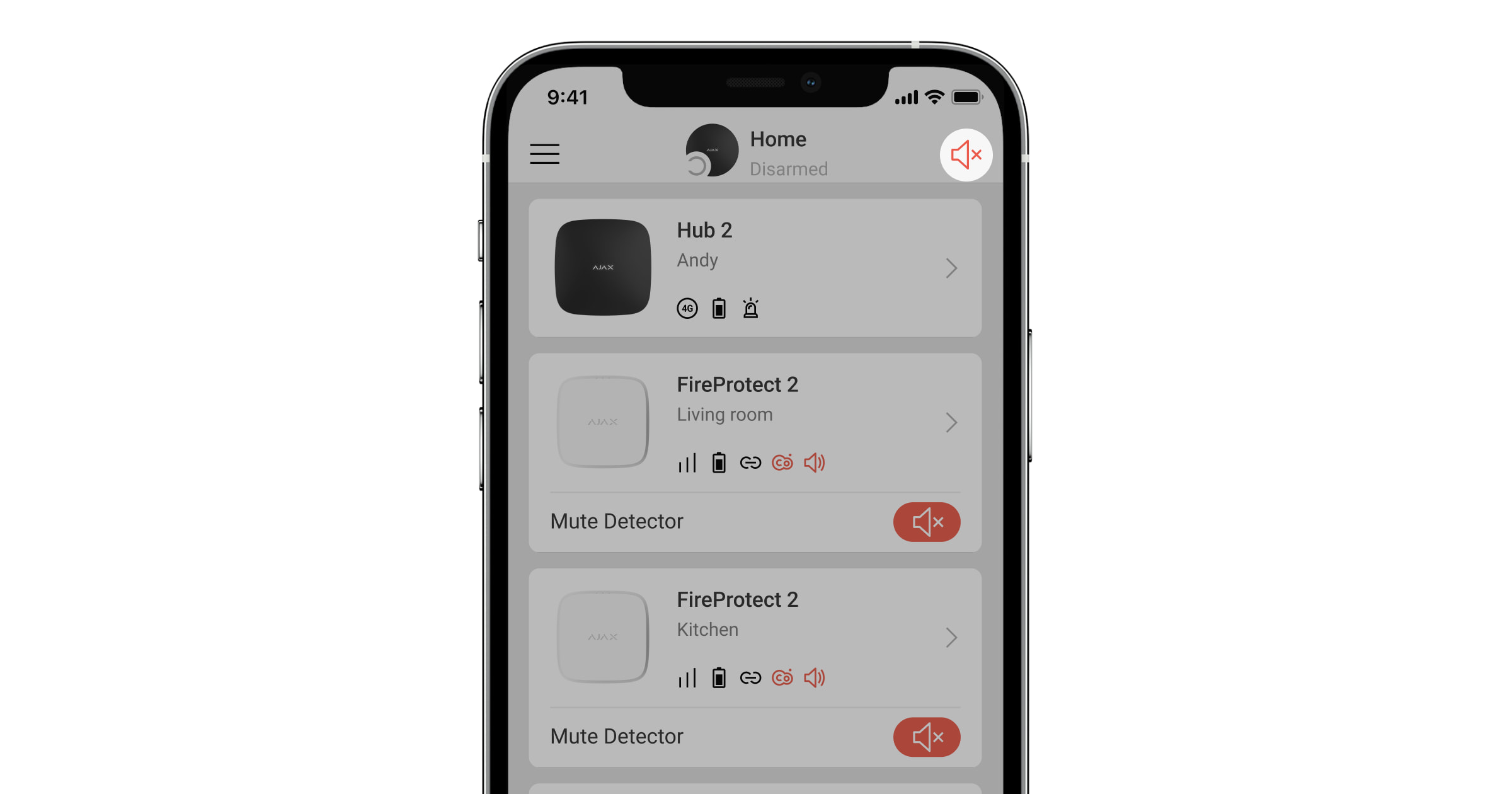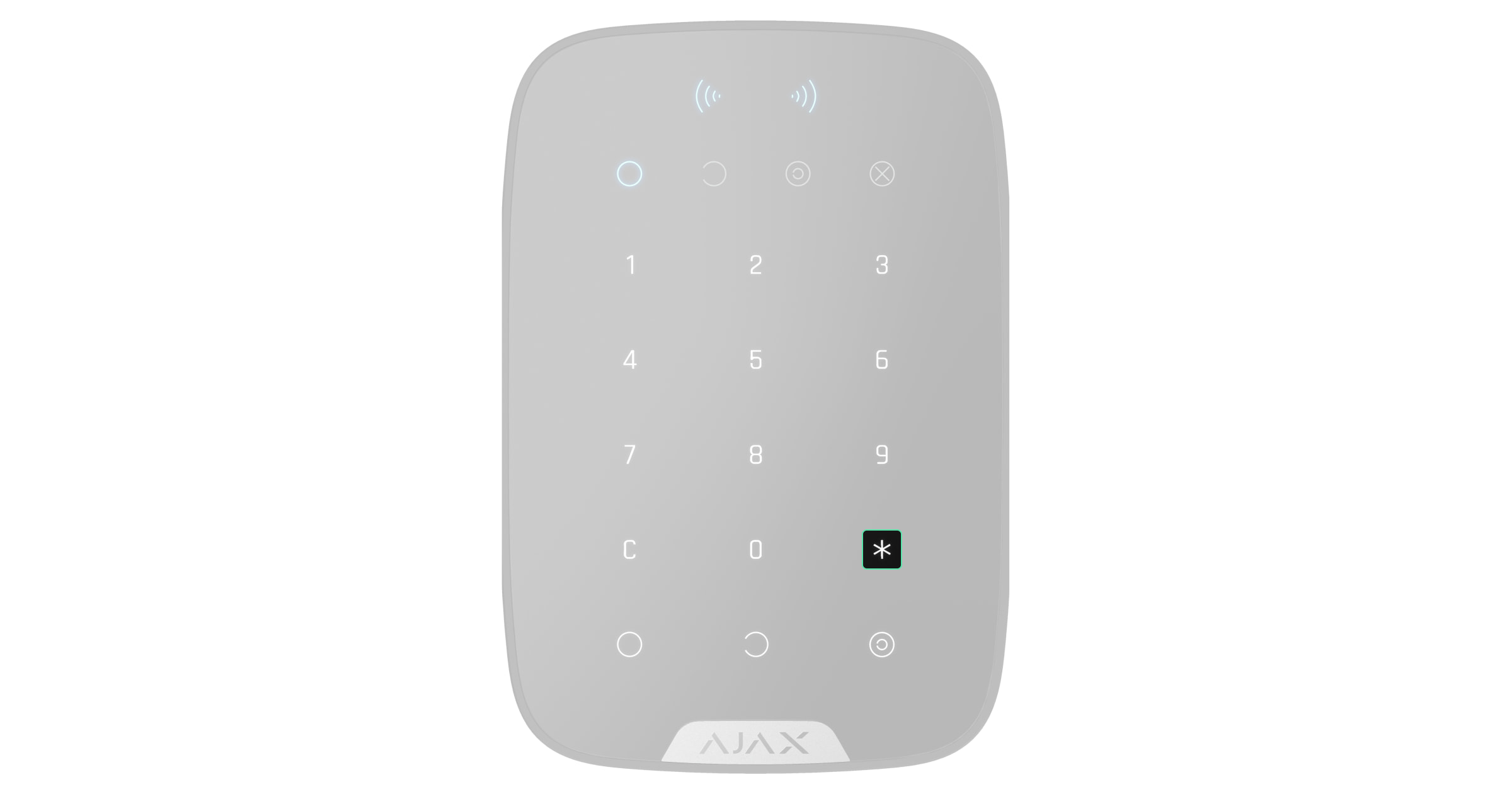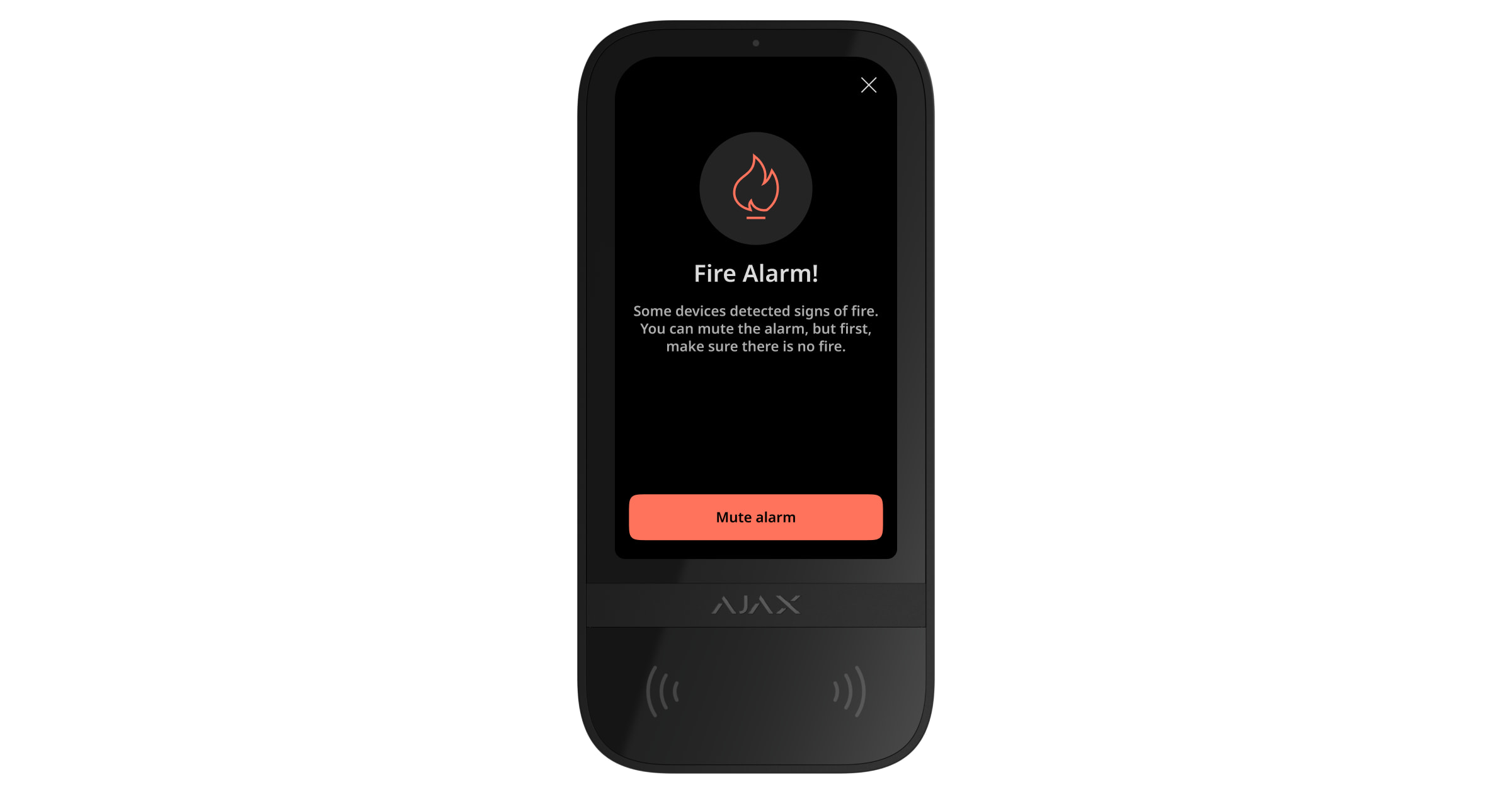All Ajax fire detectors at the object simultaneously turn on the built-in sirens if at least one of the detectors registers an alarm. Depending on the detector type, it can support one or two interconnections: primary (via Ajax hub) and fallback (detector-to-detector).
FireProtect 2 AC detectors support both interconnections that work in parallel when using the hub. In case of an alarm, the hub activates the primary interconnection. Built-in sirens of all fire detectors synchronously notify of a fire in 20 seconds. All information is instantly available in Ajax apps: initiating detector’s location, fire alarm type, and exact time. Meanwhile, the initiating detector activates the fallback interconnection. Even if connection with the hub is lost, raising the interconnected alarm takes only a minute. The fallback interconnection can also be configured without the hub, using only fire detectors.
The fallback interconnection functionality is available for hubs with OS Malevich 2.19 and later. Hub (4G) Jeweller must have OS Malevich 2.28 or later.
Other Ajax fire detectors support only the primary interconnection. The sirens of FireProtect 2 detectors, which work from batteries, are activated within 20 seconds after detecting the alarm. The sirens of FireProtect and FireProtect Plus are activated during the detector ping interval set in the Jeweller or Jeweller/Fibra settings (but no more than 60 seconds after).
Interconnected Fire Detectors Alarm is available for FireProtect and FireProtect Plus with firmware version 3.42 and higher. FireProtect 2 detectors support the feature with any firmware version.
According to European fire safety standards, in the event of an alarm, the sirens of all fire detectors in the system must be activated in less than a minute. At the same time, the volume of the notification should be at least 85 dB at a distance of three meters from the sound source. Such a siren can wake up a sleeping person when a fire occurs.
FireProtect 2 detectors have different sound and LED indications of alarm types to make it easier for users to distinguish between them. In the case of interconnected alarm, all FireProtect 2 detectors indicate exactly the alarm type detected by the initiating detector. Instead, FireProtect and FireProtect Plus detectors notify about all types of alarms with the same sound.
With OS Malevich 2.12 update, users can mute fire detector alarms in individual groups to which they have access while not affecting the operation of detectors in inaccessible groups. For Hub (4G) Jeweller this feature is available from OS Malevich firmware version 2.28 or later.
Primary interconnection
How it works
- One of Ajax fire detectors registers an alarm at the object.
- The system activates the Interconnected alarm delay if this feature is configured.
- When the delay time has elapsed, the built-in siren of the initiating detector starts an alarm. Users receive notifications if they are configured. The central monitoring station (CMS) of the security company receives an alarm notification.
- Ajax sirens installed at the object activate if this option is enabled in the settings of the initiating detector.

When the system has only FireProtect and FireProtect Plus, the system additionally starts an alarm confirmation timer. For this, the Smoke double-check option should be enabled in the hub settings. The security company’s CMS and users receive an alarm confirmation event. Interconnected Fire Detectors Alarm is activated only in one of these cases:
- The Interconnected alarm delay time has expired, and the initiating detector continues to register the alarm.
- During Interconnected alarm delay, the initiating detector registers a different type of alarm. For example, a temperature alarm is registered after detecting smoke.
- During Interconnected alarm delay, another detector in the system detects fire.
How to set up
Only an admin or PRO with the rights to configure the system can configure the fire detectors’ primary interconnection.
- Open the Ajax app.
- Select the required space.
- Go to the Devices tab
.
- Select the hub from the list of devices.
- Go to the hub settings by clicking on the
icon.
- Go to Service settings.
- Go to the Fire detectors settings menu.
- Enable Interconnected fire detectors alarm.
- If necessary, configure the Interconnected alarm delay option. It allows you to delay interconnected fire alarm propagation for a set time. The delay can be set from 0 to 5 minutes in 1-minute increments..
If the system has FireProtect and FireProtect Plus detectors and the Interconnected fire detectors alarm feature is enabled, it is impossible to set the detector ping interval (the Jeweller or Jeweller/Fibra menu in the hub settings) to more than 48 seconds.
- Click Back to save the settings.
Fallback interconnection
How it works
The fallback interconnection functionality is available for hubs with OS Malevich 2.19 and later¹ and for such FireProtect 2 AC detectors:
- FireProtect 2 AC (Heat/Smoke/CO) Jeweller
- FireProtect 2 AC (Heat/Smoke) Jeweller
- FireProtect 2 AC (Heat/CO) Jeweller
- FireProtect 2 AC (Heat) Jeweller
- FireProtect 2 AC (CO) Jeweller
¹ Hub (4G) Jeweller must have OS Malevich firmware version 2.28 or later to support the fallback interconnected feature.
Support for the fallback interconnection by other FireProtect 2 detectors is coming soon. Configure the fallback interconnection to ensure your system complies with EN 14604, EN 50291, BS 5446-2, and AS3786:2014.
The fallback interconnection can be configured for the fire detectors added to the hub or working without it. The initiating detector activates the alarm and propagates it to other detectors in one minute, even if connection with the hub is lost. The fallback interconnection works in parallel with the primary when detectors are added to the hub.
The number of fire detectors should be at most 50 to configure and activate the fallback interconnection.
If an alarm occurs in the detector network working without a hub, users will not receive notifications in Ajax apps. Only sound and LED indications of the detectors inform about the fire. If the fallback interconnection is activated in a system with a hub that has lost communication with the detectors, users will receive the corresponding notifications in the apps when the hub is back online.
How to pair detectors without the hub
To pair detectors without the hub, they must be turned on and not added to any hub.
Wait about 20 s after turning on the detectors before pairing them without the hub.
- Switch the detector to the pairing mode. To do this, press the power button on the detector 3 times briefly. Within 10 seconds, the detector will determine whether it is a master or a slave. The detector indication will differ depending on the selected role.
The maximum distance between detectors in the pairing mode is 6,500 ft in an open space.
- Repeat step 1 to add the rest of the fire detectors to the network. If the detector is in another network that works without the hub, it will be added to the new one.
The maximum number of detectors in one network is up to 50 (including the master).
- Press the detector’s power button 3 times to turn off the pairing mode.
You can add a new detector to an existing network at any time. To do so, select one detector from the network and repeat steps 1–3. - Test the coverage area of the created network to determine whether all detectors will respond to the alarm. To do this, select any detector from the network and press the Test/Mute button. The detector will first provide its self-test and then test the formed network. The detectors in the network should repeat the sound and LED indication of the initiating detector and return to the standard operating mode.
The network test will fail if one sensor of the initiating detector is malfunctioned. For the network to work correctly:
- Remove the malfunctioning detector from the network.
- If necessary, add a new detector to the network.
- Restart the test.
How to remove the detector from the network
To reset the settings of any detector and to remove it from the network, press the power and Test/Mute buttons and hold them for 10 s.
When a fire detector is added to the hub, its settings are reset, and it is removed from the network without the hub if it was a part of it.
If you add all detectors from the network to the hub, the primary and fallback interconnections must be activated in the hub service settings.
How to pair detectors with the hub
Only an admin or PRO with the rights to configure the system can configure the fire detectors’ primary interconnection.
- Open the Ajax app and select the required space.
- Go to the Devices tab
.
- Select the hub from the list of devices.
- Go to the hub settings by clicking on the
icon.
- Go to Service settings.
- Go to the Fire detectors settings menu.
- Enable Interconnected fire detectors alarm.
- If necessary, configure the Delay of Interconnected Alarms option. It allows you to delay interconnected fire alarm propagation for a set time. The delay can be set from 0 to 5 minutes in 1-minute increments.
- Enable the Fallback interconnection if hub connection lost feature.
You can’t activate the fallback interconnection if there are already 50 fire detectors in the system. To do this, delete unnecessary detectors from the hub.
When some fire detectors don’t support the fallback interconnection, you will receive a corresponding notification with the list of such detectors.
- Provide Coverage area testing to determine whether all detectors will respond to the alarm even with no connection to the hub. Select the initiating detector in the list and click Start. If some fire detectors did not respond during the test, a list of them will be displayed on the screen with the possibility to start the test again.
Coverage area test won’t start:
- If less than 2 fire detectors with the fallback interconnection support are added to the hub.
- If some detectors are offline or permanently deactivated.
- If there is a fire alarm in the system.
After configuring the fallback interconnection, you cannot add more than 50 fire detectors to the hub until you disable this fallback interconnection in the hub settings.
To reset the fallback interconnection settings, do one of the following:
- Disable the Interconnected fire detectors alarm feature.
- Disable the Fallback interconnection if hub connection lost feature.
- Press the fire detector’s power and Test/Mute buttons and hold them for 10 s.
The last condition for resetting the detector is possible if there is no connection between the hub and the detector. In this case, the detector is removed from the hub. You can manually remove the detector from the device list of the hub in Ajax apps.
How to mute interconnected fire alarm
You can mute the primary and fallback interconnection of the detectors added to the hub in several ways:
- In Ajax apps.
This way is unavailable for detectors certified by UL/ULC standards: FireProtect 2 RB (Heat/Smoke/CO) UL Jeweller and FireProtect 2 RB (Heat/Smoke) UL Jeweller.

- By pressing the Function button on Ajax keypads if the button is configured to mute Interconnected fire detectors alarm.

- By pressing the muting button on the KeyPad TouchScreen Jeweller or Superior KeyPad TouchScreen Fibra display if the Mute Fire Alarm feature is enabled.

- By pressing Button Jeweller if the device is configured to mute Interconnected fire detectors alarm.
- By pressing the Test/Mute button on the detector that initiated the alarm.
The Test/Mute button of FireProtect 2 detectors is mechanical. To mute Interconnected fire detectors alarm, press the central part of the detectors’ front panel with your hand or a suitable object. For example, use a mop handle.
FireProtect and FireProtect Plus detectors have a touch button. To mute Interconnected fire detectors alarm, touch the Ajax logo on the detector’s front panel with your hand for 3 seconds.
- By eliminating the cause of the fire alarm. In this case, the alarm is muted automatically.
If the hub loses connection with the initiating detector and the fallback interconnection is propagated, users can mute the rest of the detectors (except the initiating detector) with Button Jeweller, Ajax keypads, or Ajax apps.
The fire alarm cannot be muted on fire detectors certified by UL/ULC standards if there is a critical level of smoke in the air. Such detectors are FireProtect 2 RB (Heat/Smoke/CO) UL Jeweller and FireProtect 2 RB (Heat/Smoke) UL Jeweller.
Interconnected alarm of the detectors that are paired without the hub can be muted:
- By pressing the Test/Mute button of the initiating detector. This detector differs from the others by its LED indication: the red LED is permanently on, while the rest of the detectors’ LEDs are off. After muting, the red LED of the initiating detector flashes every 4 seconds.
- By eliminating the cause of the fire alarm. In this case, the alarm is muted automatically.
If connection with the initiating detector is lost, other detectors will stop emitting the initiator alarm within 5 minutes.
You can mute the primary and fallback interconnection for 10 min*. But they can be activated again during the muting period if:
- The initiating detector registers a different type of alarm (e.g., a temperature alarm).
- Another fire detector at the object registers the alarm.
* 5 min for the detectors certified by UL/ULC standards.